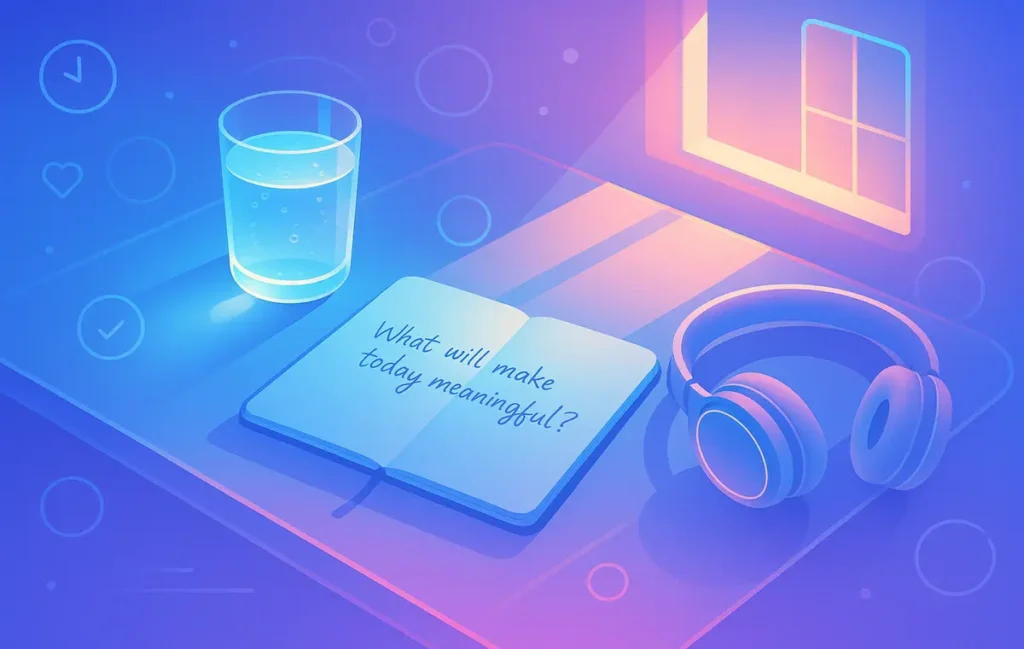🌅 Intro: Why Most Morning Routines Break by Day 10
Everyone knows mornings matter. Fewer people know why their beautifully planned routines collapse after a week. The truth is simple and a bit uncomfortable: most “perfect” routines are lists, not systems. They’re crammed with ambitious tasks that fight our biology, ignore friction, and rely on raw willpower. Habit science tells a different story. Routines that last are built as loops—cue → micro-action → reward—then layered gradually until the behavior feels automatic. In other words, the win isn’t doing more in the morning; it’s designing less resistance. In this guide, NerdChips walks you through a durable, behavior-first approach you can copy today. We’ll use cues you already have, rituals that flex with your schedule, and reinforcement that keeps you returning tomorrow. If you want the neuroscience, see Morning Routines Backed by Neuroscience. If you want something that actually sticks, keep reading.
🎯 Step 1 — Define Outcomes, Not Aspirations
You don’t need a Pinterest-perfect morning; you need a predictable one. Start by defining one concrete outcome for your first 30–60 days. “Be healthier” is vague; “20 pushups before shower” is concrete. “Be productive” is vague; “ship 300 words before 8:30 AM” is concrete. The brain favors clarity—especially right after waking when decision bandwidth is thin.
Choose metrics you can count without thinking. Word count, minutes sat for deep work, laps walked, pages read—anything with an obvious done/not-done boundary. For writers, it might be 300 words; for designers, one drafted frame; for coders, one merged PR or 45 minutes of focused build time. Track it briefly at the end of each session. A two-second tally in Notes or a habit app creates a record, and records create momentum. If you’re optimizing for focus, you’ll get even more leverage by pairing this guide with Pro Tips for Boosting Focus in a Distracted World or Beginner’s Guide to Time Blocking for Focus and Flow.
💡 Nerd Tip: Define a “minimum viable morning” (MVM). If chaos hits, you still do the MVM and earn a win. Example: drink water, breathe for 60 seconds, capture one priority. That’s it.
🧲 Step 2 — Build the First Loop: Cue → Micro-Habit → Reward
The engine of a sticky routine is one reliable loop. Pick a cue that already happens every morning: after bathroom, after coffee boils, after opening curtains. Then attach a micro-habit that takes under two minutes. Finish with a feel-good reward that’s healthy and immediate. Done consistently for two weeks, this loop becomes automatic.
Here’s a durable starter:
-
Cue: Place a full glass of water on your nightstand before sleep.
-
Micro-Habit: Sit up and finish the glass. Open a note labeled “AM Stack,” type the date, and write one sentence: “Today will be a win if I ______.”
-
Reward: Start coffee or tea. Put on your favorite focus track or open your sunrise lamp—something sensory that marks “we’re live.”
Why this works: the cue is tangible and ready; the action is so small it’s hard to skip; the reward is immediate enough to make your brain want to repeat tomorrow. From here, you can stack the next element—journaling, movement, or a 20-minute deep work block—without losing consistency.
💡 Nerd Tip: Keep your first loop “too small to fail.” You’re training identity (“I’m someone who shows up”) more than outcome in week one.
🧘 Step 3 — Design a Ritual, Not a To-Do List
Lists break; rituals bend. A ritual is a sequence with a mood. Think of it like choreography for your morning: lights, sound, placement, and pace. Switch from “what else should I add?” to “how can I make the next 30 minutes feel frictionless?” That means laying out clothes, pre-creating your writing doc, queuing your workout video, or staging your sketchbook and pencil exactly where your hands will land.
An effective ritual also limits decision points. Every choice taxes willpower. Decide the night before: which playlist, which coffee mug, which app you’ll open first, which file you’ll touch. If it sounds obsessive, that’s the point—you’re removing micro-frictions that derail early momentum.
If you’re integrating deep work, link your ritual to Deep Work 101 or time-box your most important task using the playbooks in Time Blocking vs. Pomodoro. Morning is premium attention. Spend it on generative work, not inbox ping-pong.
💡 Nerd Tip: Create a “reset shelf.” Everything your ritual needs (journal, pen, water bottle, headphones, charger) returns there before bed. Morning you will thank night you.
🔋 Step 4 — Align With Your Energy, Not Your Fantasy
Not everyone is built for 5 AM. A routine that fights your chronotype (natural sleep/wake rhythm) will fail the moment life gets noisy. If you’re an evening-peak person, shift the “heavy lift” to first two hours after you naturally wake, not before dawn. You’ll still get the benefit of fresh, unfragmented attention—without the injury of chronic sleep debt.
Two levers matter most:
-
Consistency of wake time. Even on weekends, keep a 60–90 minute band. The circadian system loves predictability—too much drift and you’ll feel Monday jet-lagged without traveling.
-
Evening automation. Put 80% of your morning setup into the night before: fill the kettle, stage your clothes, clean your desk, set app tabs. Decision fatigue is an evening problem that punishes the next morning.
If your mornings are already slammed (kids, commute, shift work), build a split routine: five-minute anchor on wake, 20-minute focus pocket later (mid-morning break or first desk time). The brain still tags the sequence as “morning,” and you’ll keep the habit intact.
💡 Nerd Tip: Protect sleep like a deliverable. The easiest way to improve a morning routine is to end screens 60 minutes before bed and let your nervous system downshift.
⏱️ Step 5 — Structure Time the Smart Way (Blocks, Not Busywork)
Good routines move in blocks. For most people, 90–120 minutes is the sweet spot for a high-quality focus block before attention starts to degrade. If you’re training attention or just starting, begin with 2 × 25-minute Pomodoro-style cycles with a five-minute reset in between. As your stamina grows, combine into longer flows. The goal isn’t punishment; it’s a steady, sustainable groove you can repeat tomorrow.
To remove friction, assign one objective per block. “Outline landing page section A” beats “work on website.” Give your future self a runway by ending each block with a single sentence for where to start next (“Tomorrow: open Figma and apply the teal variant to the hero card.”)
If you want a detailed execution guide, branch to Beginner’s Guide to Time Blocking for Focus and Flow. If you struggle with distractions, link the block to Mastering Focus in the Age of Digital Distractions and set your environment to “focus-only” (see next section).
💡 Nerd Tip: End your first block on a cliffhanger—stop mid-sentence or mid-sketch. Tomorrow’s start becomes irresistibly easy.
⚡ Ready to Build Smarter Mornings?
Get our free “AM Ritual Builder” template and stack your first two habits in 14 days. No perfection, just progress.
P.S. If you want the science side, hop to Morning Routines Backed by Neuroscience. If you want all-day structure, see How to Build a Daily Routine That Actually Sticks.
🔕 Step 6 — Engineer the Environment (Digital Hygiene Matters)
Most “broken routines” are actually noisy rooms. Give your ritual a location where distractions are physically uninvited. Place your phone in Do Not Disturb with a whitelist of true emergencies. Use a dumb timer, not your phone alarm, to mark block endings. If you’re on Mac or Windows, create a dedicated “Focus” desktop with only the apps you need. On macOS, a separate Focus profile plus Hide Dock and Do Not Disturb transforms the vibe. On Windows, a minimalist virtual desktop and Focus Assist does the same.
Pre-open only the tabs you’ll use; install a site blocker for the rest. If you need social or email for work, time-box them after you ship your primary output. If your industry demands early email, process it for ten minutes in a separate “admin lane,” then return to the creative block. The key is segregation: your brain likes knowing which lane it’s in.
For an in-depth toolkit to defend attention, use Pro Tips for Boosting Focus in a Distracted World. Pairing a clean environment with your ritual raises completion odds far more than “trying harder.”
💡 Nerd Tip: Put your phone in a different room for the first 45 minutes. Out of sight, out of mind is a productivity superpower.
🧱 Step 7 — Layer Using Habit Stacking (One Brick at a Time)
Once your first loop is automatic (usually 10–14 days), stack a second brick. Keep the new layer friction-light. Here’s a sample progression that works for most creators and knowledge workers:
-
Days 1–14: Water → one-sentence intention → coffee → 10-minute tidy desk → 20 minutes reading or journaling
-
Days 15–28: Add one 45–60 minute deep work block (writing, design, code)
-
Days 29–42: Add movement (10–15 minutes mobility or a short run) before deep work if it clears the fog
-
Days 43+: Add skill micro-practice (e.g., color grading drills, scales, coding katas) 10 minutes post-work to sharpen the blade
The idea is never to add a new layer until the previous one feels obvious. If you miss two consecutive days, revert to the previous brick and stabilize. This keeps routine debt from accumulating.
💡 Nerd Tip: Cap the total routine length. If your mornings exceed 120 minutes regularly, prune. Routines grow like vines unless you trim them.
🧪 Step 8 — Make It Feel Good (Rewards That Reinforce)
Consistency flows where reward is felt. The cleanest approach is to attach a tiny, legal dopamine hit right after your anchor task: a favorite coffee blend, a sunrise walk, a playlist you only play after writing, or even a single square of dark chocolate. Then, log a micro-win: tick a checkbox in your habit app, drop a card in your Success Jar, or move one sticky from “Doing” to “Done.”
Weekly, run a five-minute Friday Reflection: What worked? What spiked friction? What tiny tweak will make next week smoother? Keep it to one change per week. You’re building a flywheel, not a makeover show.
If rewards feel cheesy, tie them to values. “I did 45 minutes on the novel because future-me deserves a shot at authorship.” That identity framing makes today’s effort feel meaningful, not mechanical.
💡 Nerd Tip: Use variable rewards on Fridays—coffee at a new spot, your favorite pastry, or a solo walk in a different park. Novelty refreshes the loop.
🧯 Step 9 — Plan for Failure (Because It’ll Happen)
Sustainable routines expect turbulence—travel, sick kids, launches, deadlines. The fix is to define fallback modes in advance:
-
Travel Mode: 10-minute mobility + one-sentence intention + 15-minute reading.
-
Deadline Mode: Skip journaling; do a single 60-minute deep work block; admin later.
-
Recovery Mode: Sleep in 30 minutes; water + stretch; resume tomorrow.
Write these in your Notes as “If/Then” scripts. When chaos hits, don’t negotiate—execute the prewritten plan. The goal is to protect the identity of being someone who shows up, even if the payload is smaller. That identity continuity is the moat against quitting.
💡 Nerd Tip: Never miss twice. If you slip on Tuesday, Wednesday is non-negotiable. The streak matters more than the length of any single session.
⚖️ Step 10 — Keep It Flexible on Weekends (and Still Win)
Weekends derail many routines because people try to copy-paste weekdays. Give weekends a lighter choreography with the same cues but fewer steps: water, five-minute reset, 20-minute personal project or long walk, then family time. You’ll preserve momentum without resenting the routine. Monday will feel like a continuation, not a restart.
If your job demands weekend work, guard one non-negotiable joy block after the morning anchor—sketching, music practice, reading fiction. Routines that feel like life, not punishment, are the routines that last.
💡 Nerd Tip: Switch your reward on weekends—breakfast outdoors, a farmers’ market coffee, or a new playlist. Keep the ritual recognizable but let it breathe.
🧩 ✅ Morning Ritual Builder — One-Page Checklist
Use this once to design your first loop; then stop tinkering and run it for 14 days.
-
Cue: __________________ (e.g., after opening curtains)
-
Micro-Habit (<2 min): ____________ (e.g., drink water + write one sentence)
-
Reward: __________________ (e.g., brew coffee + favorite track)
-
Primary Block (45–90 min): __________________ (e.g., draft 300 words)
-
Fallback Mode: __________________ (e.g., travel version: 10-min read)
-
Weekly Reflection Friday: One tweak only: __________________
🧭 Ritual vs. Rigid Routine — Mini Comparison
| Approach | What It Feels Like | Pros | Cons | Best Use |
|---|---|---|---|---|
| Rigid Routine | To-do list with rules | Clear and decisive | Breaks under chaos; brittle | Short, predictable seasons |
| Flexible Ritual | Choreography + vibe | Adaptable; survives real life | Needs upfront staging | Long-term habit life |
🧰 Execution Templates You Can Copy
✍️ Creator Routine (60–90 minutes)
Wake → Water & one sentence → Coffee + 5-minute tidy → 45–60 minute deep writing/design block → 10-minute walk → Quick journal line (“I moved the story/design forward by…”). Pair with SEO Content Writing or Writing with AI if your morning output is publishing.
👩💻 Knowledge Worker Routine (60–75 minutes)
Wake → Water → 10-minute reading in your core field → 45-minute focus block on one needle-moving task (proposal, brief, analysis) → Admin checking only afterwards. Use How to Overcome Procrastination with Technology for friction hacks.
🧠 Deep Work Routine (90–120 minutes)
Wake → Mobility (8 minutes) → Coffee in silence → 90-minute deep work sprint (Noise off, phone out of room) → 10-minute review and next-step sentence. Connect with Deep Work 101 for cadence ideas.
💡 Nerd Tip: Put your MVM on a sticky note on your desk. On hard days, that alone still counts as a win.
📈 How to Track Without Obsessing
Over-tracking kills joy; under-tracking kills visibility. Use one of these:
-
A simple habit app with daily check and weekly streak view.
-
A paper tracker with 31 circles—color one each day you complete your MVM.
-
A spreadsheet with columns: Date, Sleep quality, Start time, Primary task, Minutes, Win statement.
Every seven days, read your last week’s wins. Decide one tweak for next week—reduce friction (stage gear), adjust timing (start 15 minutes later), or prune (remove the step you keep skipping).
💡 Nerd Tip: If you miss mornings for three days in a row, the problem is upstream. Fix evenings first.
🔄 Staying Power: The Identity Upgrade
Routines stick when they confirm who you believe you are. If you call yourself “not a morning person,” your brain will keep proving you right. Upgrade the script to something factual and empowering: “I’m someone who does one important thing before noon.” It’s accurate, flexible, and shockingly effective. Every small repeat builds that identity further. That’s why habitual, modest mornings beat intense, heroic ones. You’re engineering a default, not a highlight reel.
💡 Nerd Tip: Rename your alarm to your identity: “Author Mode,” “Builder Mode,” or “Quiet Progress.”
📬 Want More Smart AI & Focus Tips?
Join our free newsletter and get weekly insights on routines, deep work, and tools that protect your attention—delivered to your inbox. Built by creators at NerdChips.
🔐 100% privacy. No noise. Just practical playbooks you can run tomorrow morning.
🧠 Nerd Verdict
A great morning routine isn’t the one with the most boxes—it’s the one you’ll repeat on your worst Tuesday. The leverage comes from one reliable loop, a clean environment, and rewards that make you want to return. Stack slowly, align with your energy, and prune relentlessly. In a month, you won’t be chasing motivation; you’ll be riding momentum. That’s the kind of routine NerdChips loves—boringly repeatable, surprisingly powerful.
❓ FAQ: Nerds Ask, We Answer
💬 Would You Bite?
If you had to start tomorrow with only one new habit, would you choose a five-minute movement warm-up or three-sentence journal to prime your focus?
Hit reply and tell us why—your answer shapes our next templates. 👇
Crafted by NerdChips for creators and teams who want their best ideas to travel the world.



